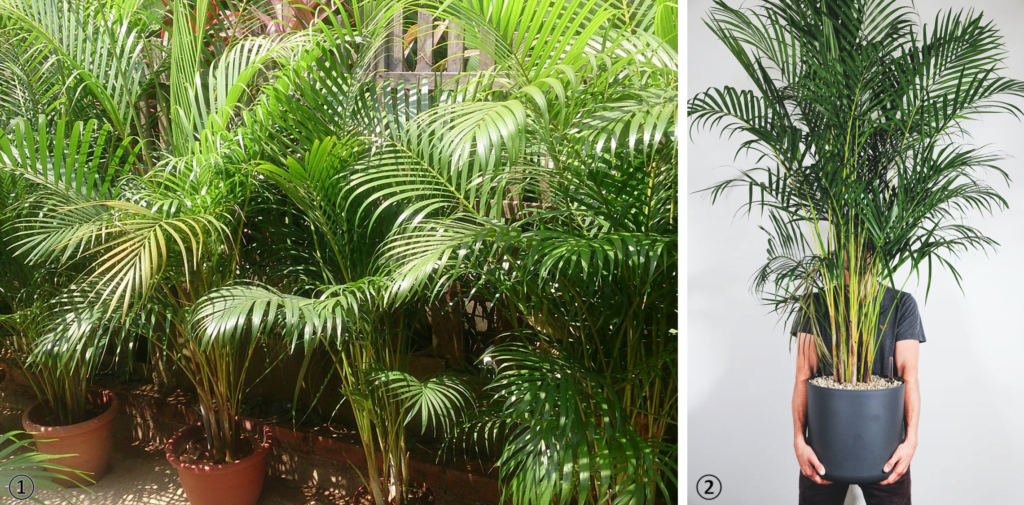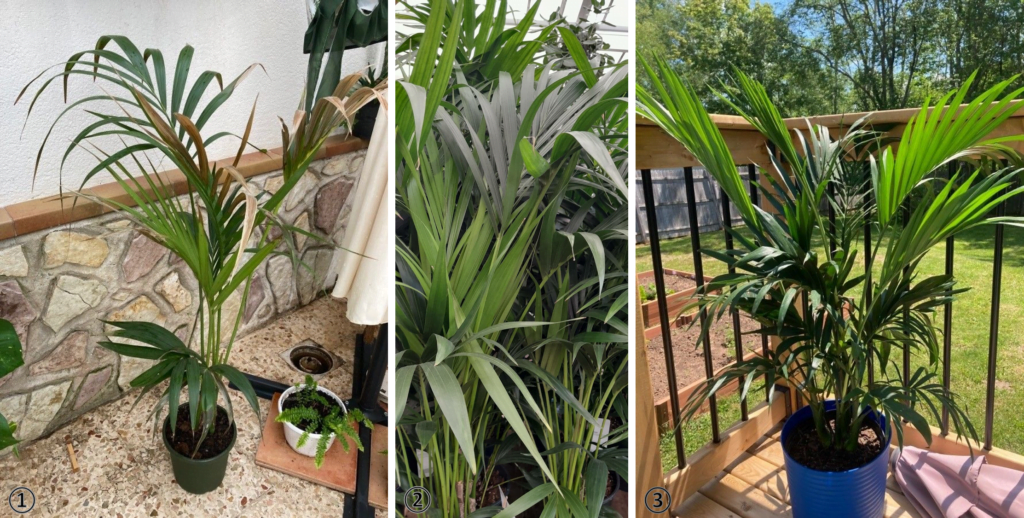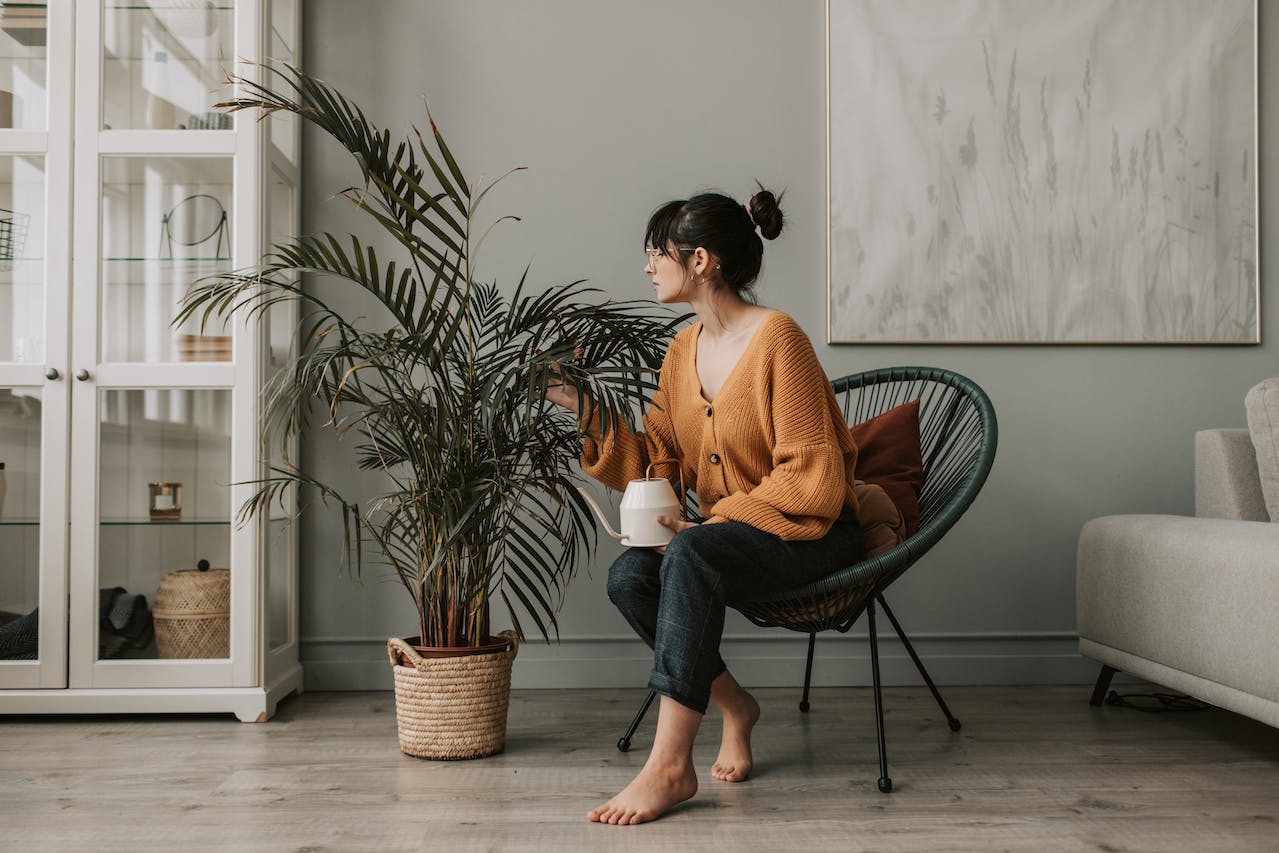Indoor palm plants serve as not only visually appealing decor but also as a gateway to a tropical oasis within your home. The vast array of indoor palm types ensures there’s a perfect fit for every space.
In this guide, we’ll explore the unique traits of the best indoor palm plants, discover their various types, and offer detailed tips for taking care of them so they can thrive in your home.
The Top 5 Indoor Palm Plants
Get ready to transform your home into a verdant paradise with these top indoor palm plants. Let’s dive in!
Areca Palm (Dypsis lutescens)
The Areca Palm, with its lush, feathery fronds, is a popular choice among the top indoor palm plants for your space. Thriving in bright, indirect light, this palm plant adds a touch of vibrancy to any room.

② Man holding areca palm pot in a dark pot. Photo by feey on Unsplash
Plant it in well-draining soil and maintain a consistent watering schedule. Carefully observe the topsoil, allowing it to dry out slightly before the next watering.
Pros: The Areca Palm includes its excellent air-purifying qualities and its ability to thrive in spaces with ample natural light.
Cons: However, it may shed older fronds, and overwatering can lead to root rot.
Kentia Palm (Howea forsteriana)
The elegant Kentia Palm boasts dark green fronds that gracefully arch, making it a sophisticated addition to any indoor setting. Adaptability to low light conditions makes it a versatile choice.

② Close-up leaves. © Fabrice Rubio (cc-by-sa) – Mar 11, 2023 / Pl@ntNet
③ Kentia palm in a blue pot. © Jessica Sivret (cc-by-sa) – Jun 12, 2021 / Pl@ntNet
Water sparingly, allowing the soil to dry out between watering sessions. While it is relatively low-maintenance, occasional misting or wiping of the fronds can prevent dust buildup.
Pros: The Kentia Palm includes its resilience in low-light environments and its air-purifying qualities.
Cons: However, it may show signs of stress if exposed to direct sunlight for extended periods.
Lady Palm (Rhapis excelsa)
Recognized for its slender stems and fan-like fronds, the Lady Palm is an excellent choice for those seeking a compact and visually appealing indoor palm plant.

② Huge lady palm with a man in the background. Photo by feey on Unsplash
Preferring indirect light, it can tolerate lower temperatures than some other varieties. Keep the soil consistently moist, avoiding waterlogged conditions.
Pros: This palm is an effective air purifier and is known for its adaptability to various indoor conditions.
Cons: It may be susceptible to spider mites, so regular monitoring is crucial.
Parlor Palm (Chamaedorea elegans)
The Parlor Palm, characterized by its compact size and delicate fronds, is well-suited for low-light conditions. Allow the soil to dry slightly between watering to prevent root rot.

② Parlor palm in a white aesthetic pot. Photo by Natalie Kinnear on Unsplash
This indoor palm plant is an excellent choice for beginners due to its forgiving nature.
Pros: The Parlor Palm includes its adaptability to low-light environments and its low-maintenance care requirements.
Cons: May be sensitive to overwatering, leading to yellowing of fronds.
Bamboo Palm (Chamaedorea seifrizii)
With tall, slender stems and gracefully arching fronds, the Bamboo Palm is a striking addition to indoor spaces. Flourishing in bright, indirect light, this indoor palm plant requires consistently moist soil.

② Showing the slender stems of Chamaedorea seifrizii in a dark gray pot. © Manuëlle (cc-by-sa) – Feb 13, 2022 / Pl@ntNet
③ Scattered bamboo palm in a glazed white pot with a gnome. © Jamie Radin (cc-by-sa) – Dec 19, 2020 / Pl@ntNet
Fertilize during the growing season with a balanced liquid fertilizer. While it excels as an air purifier, it may attract spider mites, so regular checks are advisable.
Pros: Bamboo Palm includes its adaptability to various light conditions and its effective air-purifying qualities.
Cons: May require more frequent watering than some other palm varieties.
Ideal Spaces for Indoor Palm Plants
Selecting the right placement for your indoor palm plants is crucial for their well-being and aesthetic impact.
These versatile plants can thrive in various spaces, adding a touch of tropical elegance to different areas of your home or office.
- Living Room:
- Elevate the visual appeal of your living room by placing a statement palm, like the Areca or Kentia, in a well-lit corner.
- Consider floor-standing palms or place smaller varieties on side tables to complement your existing decor.
- Bedroom:
- Introduce a calming ambiance to your bedroom with a compact palm like the Parlor Palm.
- Opt for varieties that thrive in low-light conditions to create a serene and cozy atmosphere.
- Home Office:
- Boost productivity and create a refreshing work environment by incorporating a Lady Palm or Bamboo Palm in your home office.
- Position the palm near a source of natural light to enhance concentration and reduce stress.
- Bathroom:
- Some palms, like the Bamboo Palm, thrive in humid conditions, making them ideal for bathrooms.
- Place palms on countertops or consider hanging varieties to maximize space while adding a spa-like feel.
- Kitchen:
- Introduce greenery to your kitchen with palms that can tolerate lower light conditions, such as the Parlor Palm.
- Place smaller palms on windowsills or use hanging varieties to add a touch of nature without taking up valuable counter space.
- Hallways and Entrances:
- Create a warm and welcoming entryway by incorporating tall palms like the Kentia or Bamboo Palm.
- Use decorative pots or planters to enhance the aesthetic appeal and make a statement as soon as guests enter your home.
- Workplace or Reception Areas:
- Enhance the atmosphere of your workplace or reception area with palms like the Areca Palm.
- Position them strategically to provide a sense of greenery without obstructing pathways or workspaces.
- Empty Corners or Alcoves:
- Utilize empty corners or alcoves by placing larger palms, such as the Bamboo or Kentia, to fill the space with vibrant foliage.
- Tall palms can act as natural room dividers, defining different areas within an open-concept living space.
Whether you’re aiming for a cozy retreat or a vibrant focal point, the right placement can maximize the impact of your indoor palm plants, creating a harmonious blend of nature and interior design.
Tip: Remember to consider the specific light requirements of each palm variety and match them to the characteristics of the chosen space.
Maintenance and Care Tips

Lighting
Most indoor palm plants thrive in bright, indirect light. Place them near windows, but shield them from direct sunlight, which can scorch the leaves.
Rotate the plant periodically to ensure even exposure.
Watering
While palm plants prefer consistently moist soil, overwatering can lead to root rot. Allow the top inch of soil to dry before watering, adjusting the frequency based on the specific plant’s needs.
Use a well-draining pot to prevent waterlogged conditions.
Humidity
Mimic the tropical environments these plants originate from by maintaining a moderate level of humidity. Mist the leaves regularly or use a humidifier, especially during dry winter months.
Grouping plants together can also create a microclimate with higher humidity.
Temperature
Indoor palm plants generally prefer temperatures between 65-80°F (18-27°C). Avoid exposing them to drafts or sudden temperature fluctuations.
Protect them from cold drafts, as this can lead to stress and leaf drop.
Fertilization
Feed your palm plants with a balanced liquid fertilizer during the growing season (spring and summer). Reduce fertilization in fall and winter when growth slows.
Follow the recommended dosage on the fertilizer packaging, as over-fertilizing can harm the plant.
Pruning
Remove yellow or brown fronds regularly to promote overall plant health. Trim with clean, sharp scissors or pruning shears.
Pruning encourages new growth and maintains the plant’s aesthetic appeal.
Pest Control
Keep an eye out for common pests like spider mites or scale insects. Use insecticidal soap or neem oil to treat infestations promptly.
Regularly inspect the undersides of leaves where pests often hide.
Repotting Indoor Palm Plants
Repotting indoor palm plants is a simple yet essential task to keep your green haven flourishing.
Knowing when and why to repot, along with the proper techniques, ensures the continued health and vitality of your tropical companions.

When to Repot
Look for signs like roots emerging from drainage holes, slow growth, or top-heavy plants. Spring or early summer is the ideal time for repotting when palms are entering a period of active growth.
Why Repot
Repotting provides fresh, nutrient-rich soil, eliminates compacted roots, and allows for better drainage. It also offers a chance to inspect roots for disease or pests, promoting overall plant health.
How to Repot
- Choose the Right Pot: Select a pot 1-2 inches larger in diameter with drainage holes.
- Use Proper Garden Tools: Prefer to use tools such as copper gardening tools to make repotting more efficient.
- Prepare New Soil: Use a well-draining potting mix or create a mix with soil and perlite.
- Gently Remove the Plant: Water a day before, turn the pot upside down, tap to release, and inspect roots.
- Trim Roots if Needed: Trim damaged or excessively long roots with clean, sharp scissors.
- Place in New Pot: Position in the center, and add fresh soil, and water thoroughly.
- Care Tips After Repotting: Avoid direct sunlight initially, monitor moisture levels, limit fertilization for a month, and provide support if the plant is top-heavy.
Repotting indoor palm plants is a quick and rewarding task that revitalizes their well-being.
With a keen eye for signs and proper techniques, you can easily ensure your palms continue to thrive, bringing a touch of the tropics into your home.
Pros and Cons of Having Indoor Palm Plants
Bringing the lush greenery of indoor palm plants into your living space is a delightful way to enhance aesthetics and well-being. However, like any gardening endeavor, it comes with its own set of considerations.
In this section, we’ll delve into the pros and cons of having indoor palm plants, offering insights to help you make informed decisions about incorporating these tropical wonders into your home.
From improved air quality to potential challenges, let’s navigate the verdant landscape of indoor palm ownership.
Pros
- Improved Air Quality: Indoor plants, including palm varieties, contribute to better air quality by absorbing pollutants and releasing oxygen.
- Aesthetic Appeal: Indoor plants enhance the visual appeal of your home, bringing in natural elements and creating a calming ambiance.
- Stress Reduction: Interacting with indoor plants has been linked to reduced stress levels and improved overall well-being.
- Humidity Regulation: Plants release moisture through a process called transpiration, helping to regulate indoor humidity levels.
Cons
- Pest Susceptibility: Indoor plants may attract pests like spider mites or scale insects, requiring vigilant monitoring and prompt action.
- Overwatering Risk: Enthusiastic watering can lead to root rot, especially in palms. Careful attention to soil moisture is crucial to avoid this issue.
- Space Requirements: Some larger palm varieties may require significant floor space, limiting placement options in smaller living spaces.
- Specific Care Needs: Different palm types have unique care requirements, necessitating research, and attention to ensure proper growth and health.
Conclusion
Indoor palm plants can transform your living space into a lush, tropical haven when cared for properly.
By choosing the right type for your environment and following these maintenance and care tips, you’ll enjoy the beauty and benefits of these elegant plants year-round.
Remember, each palm variety may have unique requirements, so pay attention to the specific needs of your chosen plant to ensure its optimal health and longevity.
Also Read: Choosing the Best Garden Fence Panel: A Comprehensive Guide
Well, what do you think about the article?
Did you enjoy reading “The Ultimate Handbook on Indoor Palm Plants“? We really hope that you have enjoyed this article. If you have any thoughts or comments about this post, please feel free to share them in the comment section below. We appreciate your feedback and would be glad to hear from you.
To see more content like this check the gardening section of Money For My Beer.

Lara is a freelance content writer and a cat mom to three furbabies, Mizu, Haru and Sora.
She graduated with a Bachelor’s Degree in Architecture and is a registered and licensed Architect. Aside from writing, she is fond of growing cacti and succulents and is a DIY type of girl.
During her free time, she engages herself in water-colouring and crocheting, while catching-up with an old tv series she just discovered. Lara loves to explore new places, but most of the time stays in her hometown province, reading historical romance novels over a cup of coffee – or matcha.

